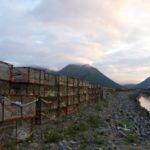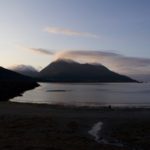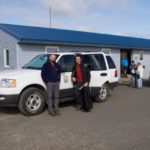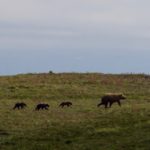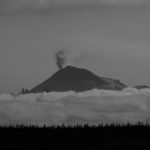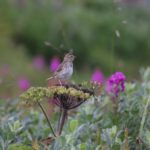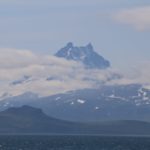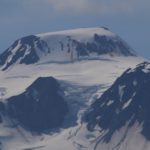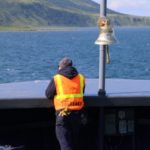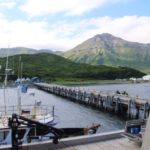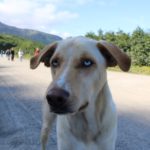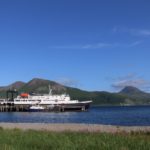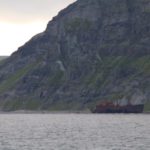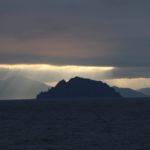29 July 2016.
The day started early as the first port of cold was King Cove at 7:15am. King Cove is a small port surrounded by smooth conical peaks. The early sun painted the lenticular clouds above the summit, and the Tustumena landed in the shade of these gigantic mountains. This was a short stop, barely over half an hour. I asked one of the local crew members on the dock if they had seen monkeyflowers. “Yes, it is everywhere”, answered a girl about 20 that was securing the ferry with heavy ropes. “Where could I find the nearest ones?” I asked. It was hard for her to decide: “Go right, no, perhaps left, there are very many.” Lo and behold we found monkeyflowers in a yard to the left, where the fishermen kept crab traps and other gear. Strangely, Mimulus was growing on the dry ground away from a stream or an obvious water source. The soil, though, showed that at some point this area is flooded, and the drought is only transitory. We found many small plants, with lots of seeds. I picked a few plants for herbarium records. I walked a bit further, towards a sandy beach and I surprised a red fox searching for food on the edge of the water. Startled, the fox ran into the vegetation as I fruitlessly shot my camera to get some blurry pictures of a red dash. King Cove have given us a treasure of Mimulus, in about 20 minutes. Not a bad way to start the day.
The next stop was Cold Bay at around 11am. This is one of the most exciting stops of the trip, as it is here where the headquarters of Izembek National refuge is. On the ship we had met the new manager of the Refuge, who was travelling with his two dogs. Traditionally, the ferry holds a lottery to choose 20 lucky passengers that are then taken on a 2 hour tour of the Reserve. Josh and I were lucky enough to go, while Jannice had to stay behind picking cloudberries.
The tour was fantastic. We learned about this last frontier of US land conservation. A big reserve set to protect eelgrass, which feeds thousands of migratory birds including Brent goose who arrive here every year after migrating from Baja California. About 2km into the reserve, a passenger shouted “Bear!” and our truck slid into a halt. While everybody looked for the (non-exisitent bear) I spotted monkeyflowers on a stream. Unfortunately I was not allowed to stop to collect so I could only mark the site with my GPS while we drove away. But our spirits were lifted when barely 1km away we did spot a brown bear. A large female bear rose from a low hill, followed by three cubs. The wind carried our scent and she stopped and looked, then ran a few dozen meters leaving the cubs to hurriedly catch up. Then she ran and stopped again, playing this game, while keeping an eye on us, until they reached a lake. It was a great sighting of this bear family. We continued with the tour of the refuge, hearing the story of the place, people and wildlife.
A definite highlight was to see the four volcanoes poking their head out from the clouds. Seeing these volcanoes is not assured in a short stop in Cold Bay. The ever present clouds is the very reason why the US military chose this site for a base during the warm up to the Second World War, hoping that they could hind military structures from the Japanese bombers.
The most interesting volcano was Pavlov, which was smoking, producing a thin flume that raised up far in the sky. Seeing a smoking volcano here was among the list of things I really wanted to see. After all we are sailing in the Ring of Fire, and an active volcano makes justice to this awesome name.
We eventually came back to the ferry a bit late, just to find that Jannice had fished a fairly good-sized fish with a borrowed rod that a kid and his dad take out at every stop. Oh, and I was forgetting, that when we arrived to Cold Bay we were also received by the locals, but this time two entrepreneurial kids were selling Japanese glass bubbles. These beautiful bubbles wash now and then in Alaskan beaches. They were used by Japanese fishermen to keep their nets afloat, and sometimes were lost or thrown overboard. Now replaced by plastic floaters, these glass bubbles are not only of historical interest but also extremely beautiful.
Next stop was False Bay. As we approached we kept an eye for wildlife. There were hundreds of tufted puffins floating on swirls at the mouth of the bay. Josh and Jannice also say a bear and cubs. At port, we had a bit more than an hour and a half, and within a few minutes we found monkeyflowers on the side of the road. It was a successful stop into this small community with population of 54. At the end of the pier there was a bunch of entrepreneurial kids selling lemonade, banana loaf, and glass bubbles. I couldn’t resist and bought another bubble, this time still surrounded by the original net. And banana loaf which I am having with tea in my little homage to Gillian and Lucia back home in Scotland.
After dinner I sat in the front deck near the bow of the ship. The Captain pointed out the wreckage of the Oduna, a ship that sunk at the coast in 1965. The rusting hull lay inclined against the rock cliffs. The sunset was ferocious, with low cloud acting as a lid that touched the tops of the conical volcanos and jagged mountains. In a curious natural phenomenon, a hole pierced the cloud just above a lonely island, and showered the bare rock with light. In the background, what at first looked like clouds, turned out to be a massive mountain range with snow covered peaks, and even higher than the volcanos of the background. At 10:30pm a pod of eight whales passed on both sides of the ship. The ship rocks softly, and the sun refuses to abandon the mountain peaks.

